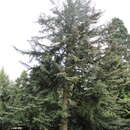(Learn how and when to remove this template message)
Abies chensiensis, the Shensi fir, is a fir native to Gansu, Hubei, Sichuan, Tibet, Yunnan in China, and Arunachal Pradesh in India. It was first described by Philippe Édouard Léon Van Tieghem in 1892.[1][2]
Description
The Shensi fir is a straight-stemmed, evergreen tree, which can reach heights of up to 50 m (160 ft) and can have a diameter at breast height of up to 250 cm (98 in).[3]
Tallest tree
The tallest measured specimen is 83.2 m (273 ft), with a circumference of 2.07 m (6 ft 9 in) of Abies chensiensis var. salouenensis variety, discovered at an altitude of around 2,300 meters in large primeval forest of Zayü County, Nyingchi Prefecture, Tibet Autonomous Region, China in 2022 and according to the Institute of Botany of the Chinese Academy of Sciences it the tallest tree in the China.[4][5][6]
Varieties and synonyms
Abies chensiensis varieties and its synonyms:[7]
- Abies chensiensis var. chensiensis
-
Abies chensiensis var. ernestii (Rehder) Tang S.Liu
-
Abies beissneriana Rehder & E.H.Wilson
-
Abies ernestii Rehder
-
Abies recurvata subsp. ernestii (Rehder) Silba
-
Abies recurvata var. ernestii (Rehder) Rushforth
-
Abies chensiensis var. salouenensis (Bordères & Gaussen) Silba
-
Abies chensiensis subsp. salouenensis (Bordères & Gaussen) Rushforth
-
Abies ernestii var. salouenensis (Bordères & Gaussen) W.C.Cheng & L.K.Fu
-
Abies recurvata var. salouenensis (Bordères & Gaussen) C.T.Kuan
-
Abies salouenensis Bordères & Gaussen
-
Abies chensiensis var. yulongxueshanensis (Rushforth) Silba
-
Abies chensiensis subsp. yulongxueshanensis Rushforth
Distribution
The natural distribution of the Shensi fir is roughly bounded to the north by the Chinese provinces of Shaanxi and Gansu, and to the south by the Yunnan province. It most commonly grows in heights of 2300 to 3000 metres in regions with an annual precipitation between 1000 and 2000 mm.[8]
Uses
The soft, light timber of the Shensi fir is finely grained, and is predominantly used as a construction material.
See also
References
-
^ a b Farjon, A.; Li, J.-y.; Li, N.; Li, Y.; Carter, G.; Katsuki, T.; Liao, W.; Luscombe, D.; Qin, H.-n.; Rao, L.-b.; Rushforth, K.; Yang, Y.; Yu, S.; Xiang, Q.; Zhang, D (2011). "Abies chensiensis". IUCN Red List of Threatened Species. 2011: e.T42274A10675568. doi:10.2305/IUCN.UK.2011-2.RLTS.T42274A10675568.en. Retrieved 17 November 2021.
-
^ "Abies chensiensis". International Plant Names Index (IPNI). Royal Botanic Gardens, Kew; Harvard University Herbaria & Libraries; Australian National Botanic Gardens. Retrieved 11 March 2009.
-
^ conifers.org / Abies chensiensis | The Gymnosperm Database
-
^ english.cas.cn / 83.2 Meters! China's Tallest Tree Discovered in Tibet; Editor: CHEN Na | May 21, 2022
-
^ english.cas.cn / China's Tallest Tree Found in Tibet; Editor: LIU Jia | May 19, 2022
-
^ chinadaily.com.cn / China's tallest tree discovered in Tibet; By ZHANG ZHIHAO | Updated: 2022-05-18]
-
^ science.kew.org / Abies chensiensis Tiegh.
-
^ Christoph J. Earle. "The Gymnosperm Database - Abies chensiensis". conifers.org. Archived from the original on 30 April 2019. Retrieved 25 September 2019.


